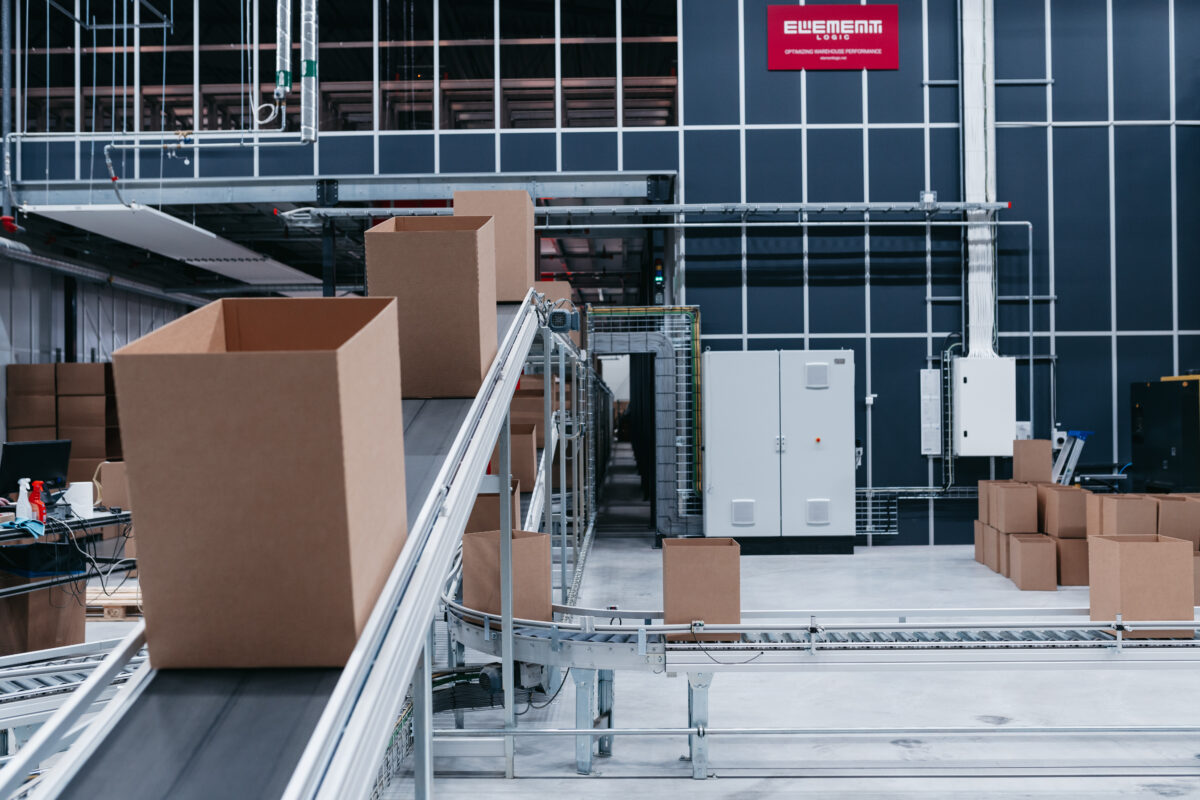E-commerce fulfillment is of vital importance whether you are a new company entering the game, an established organization introducing this part of fulfillment, or an organization trying to scale to keep up with the demand that’s been growing out of proportion. The bottom line is that you need to know how to handle orders!
Logistics has become essential, and with it, the ability to navigate materials seamlessly has become an inseparable part of the e-commerce industry. Customer expectations are high, and there’s no time to waste if you want to stay afloat, let alone compete with an ever-growing market.
What is E-commerce Fulfillment?
Definition: E-commerce fulfillment is the process of storing, packing, and shipping online orders. This includes picking from shelves, packing orders, organizing Stock-Keeping Units (SKUs), and even handling returns.
The E-commerce Fulfillment Process
Typically, order fulfillment encompasses the 6 following components: …
- Inventory Management: Managing incoming stock.
- Inventory Storage: Best practices for storing products.
- Order Processing: Efficient handling and packaging of orders.
- Pick & Pack – Verified goods selected and packaged.
- Shipping: Choosing carriers and managing logistics.
- Returns Management: Handling returns and exchanges.

- Inventory Management – the entire lifecycle of ordering, storing, using, and selling your company’s inventory. It may also include the management of raw materials, components, and finished products, as well as warehousing and processing items.
- Inventory Storage – Warehouses serve as strategic hubs where products and materials can be stored, organized, and efficiently managed. A properly optimized warehouse that utilizes inventory management systems plays a crucial role in ensuring timely order fulfillment and a seamless customer experience.
- Receiving – a pivotal step where incoming goods are carefully inspected, logged, and fully integrated into a warehouse’s inventory. In streamlining the receiving operations, you will be able to maintain accurate stock levels, reduce the overall processing times, and ultimately enhance the efficiency of the supply chain.
- Pick & Pack – the stage where items are selected from warehouse shelves or bins and verified for accuracy before being packed for shipping. Efficient pick and pack operations, which are often supported by automation and smart software, contribute significantly to order accuracy, expedited processing times, and cost-effective fulfillment.
- Shipping – the “end of the line,” so to speak. This phase involves the careful packaging, labeling, and dispatching of orders to customers. In streamlining shipping operations, businesses ensure timely deliveries, cost-effective transportation, and consistently meet customer expectations for a shopping experience that they are all too eager to share!
- Returns – this process involves the handling and processing of product returns initiated by customers. Having transparent returns policies is of the utmost importance and, when they are supported by a streamlined e-commerce fulfillment plan, can aid in maintaining high levels of customer satisfaction and building trust within the industry.
Importance: Fulfillment plays a pivotal role in the success and sustainability of online businesses because you will waste less money and resources fumbling with an iron-clad e-commerce operation.
Additionally, fulfillment has a direct impact on customer satisfaction. A well-executed fulfillment process ensures that products are not only delivered on time but also arrive in excellent condition, thereby enhancing the overall customer experience. These positive encounters are instrumental in fostering customer loyalty and encouraging repeat business which, in a fiercely competitive industry, gives your business a competitive edge.
Types of E-commerce Fulfillment Strategies

In House Fulfillment
In-house fulfillment is the most standard e-commerce fulfillment strategy and has been used for mail-order businesses for years. In this model, the business purchases and stores all of its own inventory and also fulfills and ships all of its own orders for customers.
By handling every step of the order fulfillment process, this model has the most control over inventory pricing, storage, shipping, and customer experience. However, it also means they are solely responsible for facilitating and managing these complex processes. Here are the benefits and disadvantages of in-house fulfillment for e-commerce.
Benefits of In House Fulfillment:
- Discounted unit prices for bulk purchases
- Visibility and control over costs
- Oversight of fulfillment and shipping services
- Management of the customer experience and customer data
Disadvantages of In House Fulfillment:
- High overhead costs (warehouse, employment expenses, utility costs, etc.)
- Time-consuming to own every aspect of the business
- Inventory demand planning is critical to success
- Comprehensive staffing and warehouse management are required for success
- Difficult to test out new products
Fulfillment Companies
In a fulfillment company model, the e-commerce business purchases its inventory in bulk, but instead of storing and shipping orders to customers themselves, it uses a fulfillment center. This means the business has control over the initial inventory management, and then they pass ownership to the fulfillment center for the receiving, storing, and shipping of goods to customers.
With fewer overhead costs, profit margins are determined by the costs of the goods and the fees from the fulfillment company.
Benefits of Fulfillment Companies:
- Discounted unit prices for bulk purchases
- Lower overhead costs (warehouse, employment expenses, utility costs, etc.)
- Time saved by outsourcing warehouse and shipping operations
Disadvantages of Fulfillment Companies:
- Demand planning is critical to success
- Less control over the customer journey, including fulfillment and shipping services
- Limited power over customer data
- Difficult to test out new product.
Drop Shipping
Using a drop shipping model makes the e-commerce business a proverbial “middleman” rather than a standard vendor. For instance, customers purchase orders through the e-commerce website, and those orders are passed directly to the drop shipper. Then, the drop shipping company, usually a manufacturer or a specialized warehouse, packages and ships the goods directly to the buyer.
This model outsources every aspect of the inventory management, warehousing, and shipping processes. Likewise, the e-commerce business focuses solely on the marketing, selling, and customer service aspects of the business.

Benefits of Drop Shipping:
- Low overhead (warehouse, employment expenses, utility costs, etc.)
- Time saved by outsourcing inventory, warehousing, and shipping
- Demand planning is not as significant, there’s never a risk of overstocking a product
- It’s easy to test out different products on new audiences
Disadvantages of Drop Shipping:
- Pay a higher price per unit since products are not purchased in bulk
- No control over the supply chain
- Profit margins depend on prices negotiated with the drop shipper
- Less control over the customer journey, including inventory, fulfillment, and shipping services
- Very limited customer data and insights
Challenges in Ecommerce Fulfillment

1.) Balancing stock levels.
Balancing stock levels in e-commerce fulfillment poses a significant challenge for businesses, largely due to the fluid and dynamic nature of consumer demand and the complexities surrounding inventory management. The reasoning behind this is because of the delicate balance one must find in having enough stock to meet customer orders promptly while avoiding overstock situations that can lead to increased storage costs and even potential losses.
E-commerce businesses will often find themselves grappling with the unpredictability of demand, seasonal fluctuations, and market trends that can change at a whim. The uncertainty of it all can pose a serious hurdle to accurately forecast and adjust stock levels accordingly.
To overcome these challenges, businesses must strike the right balance. This will often require sophisticated inventory management systems that leverage data analytics, historical sales patterns, and real-time insights to optimize stock levels. Regular monitoring, data-driven insights, and a proactive approach to adjusting stock levels can help businesses navigate the intricacies of inventory management in e-commerce fulfillment and maintain a responsive and efficient supply chain.
2.) Overcoming logistical hurdles.
Overcoming logistical hurdles is a critical aspect of e-commerce fulfillment, and it comes with its share of challenges. One of the primary obstacles is the complexity of last-mile delivery, where products must be transported from distribution centers to the end customer. Navigating through diverse delivery locations, managing varying delivery time windows, and handling the intricacies of urban and rural deliveries can pose significant challenges.
Another common challenge in shipping and logistics is cost management. Balancing the need for timely and reliable delivery with the cost-effectiveness of the logistics chain is a delicate task. Rising fuel costs, transportation expenses, and the need for advanced tracking and delivery technologies contribute to the complexities of maintaining a cost-efficient yet high-quality logistics network.
Probably the largest logistical hurdle to overcome within the e-commerce fulfillment industry is handling returns. According to Shopify, consumers returned products worth $817 billion (which is over 16% of total retail sales) and cost businesses roughly $101 billion, according to the National Retail Federation. This is why crafting a thorough process for handling product returns should be of the highest priority for an e-commerce company. This means they must research reverse logistics, inventory management for returned items, and effective communication with customers to ensure a positive experience regardless of whether or not they return an item.
3.) Meeting delivery promises and handling issues.
Meeting customer expectations is a complex task because of the increasing demand for fast and reliable shipping. Customers have become accustomed to quick deliveries, and they expect their orders to be fulfilled promptly, which poses pressure on businesses to optimize their logistics and last-mile delivery processes.
The accuracy of delivery promises is crucial, and businesses often encounter challenges in estimating realistic delivery times. External factors such as weather, unexpected delays in transportation, or peak seasons can disrupt the fulfillment timeline, making it difficult to consistently meet promised delivery windows.
To overcome these challenges, businesses invest in advanced tracking and communication systems, enabling customers to monitor the status of their orders in real-time. Proactive communication about any delays or issues, along with transparent and user-friendly return policies, helps manage customer expectations. Leveraging technology for customer support, including chatbots and automated systems, assists in addressing common issues efficiently.
Technological Innovations in Fulfillment
Automation in Fulfillment: How automation enhances efficiency.
Automation is easily one of the largest and most impactful technological innovations within the e-commerce fulfillment industry. Automated systems play a crucial role in significantly elevating operational efficiency by expediting the order fulfillment process. Robotics, such as an automated retrieval and storage system (ASRS), have streamlined order picking and packing, leading to increased accuracy and faster processing times. These technologies, like AutoStore, enable warehouses to efficiently locate and organize items, minimizing errors and enhancing the overall speed of order preparation.
The efficiency from automation extends to sorting and conveyance within fulfillment centers as well. Advanced conveyor systems and sortation technologies automatically route products to their designated areas, reducing the need for manual intervention. This not only expedites the movement of goods within the warehouse but also contributes to a seamless and organized workflow. Additionally, the integration of autonomous vehicles, such as drones and AGVs, further reduces reliance on manual labor, allowing for swift and efficient transportation of items within the facility.

Integration of AI and Machine Learning: Predictive analytics in inventory management.
The integration of artificial intelligence and machine learning has revolutionized e-commerce fulfillment, offering businesses unprecedented insights and capabilities to enhance efficiency and customer satisfaction. In the realm of order fulfillment, AI and machine learning technologies are employed in various capacities, starting with demand forecasting. Advanced algorithms analyze historical data, consumer behavior, and market trends to predict future demand accurately. This allows businesses to optimize inventory levels, ensuring products are available when needed, thereby reducing the likelihood of stockouts or overstocks.
The integration of AI and machine learning in e-commerce fulfillment represents an overall paradigm shift, enabling businesses to not only meet current demands but also adapt to future challenges. As these technologies continue to advance, the potential for further innovation in optimizing various facets of the fulfillment process remains significant, ultimately contributing to a more agile, responsive, and customer-centric e-commerce ecosystem.
The Future of Robotics in Fulfillment: Case studies and potential.
As briefly touched on in the automation section above, the future of robotics in e-commerce fulfillment holds immense promise, transforming the industry by introducing unprecedented levels of automation and efficiency. Robotics are increasingly becoming integral to the fulfillment process, particularly in areas such as order picking and packing.
A prime example is the Apotea Case Study, which embraced a fully automated warehouse model. Their maximum capacity was significantly strengthened by installing AutoStore from Element Logic, allowing them to deliver approximately 50,000 orders a day. By implementing robotic systems for order fulfillment for the entire process, including eOperator, Apotea has been able to achieve remarkable efficiency gains while their piece-picking and packing robots work around the clock … even in the dark!
Best Practices for E-commerce Fulfillment
Mastering the art of e-commerce is imperative for businesses aiming to provide a gratifying experience to their customers. There are several key best practices that stand out in this domain that contribute to the success of e-commerce operations.
From the strategic optimization of inventory turnover to the meticulous consideration of packaging, branding, and communication strategies aimed at enhancing customer experience, these practices are pivotal. Additionally, making data-driven decisions can reshape the future of e-commerce fulfillment, promising increased efficiency and adaptability.
Embracing these best practices empowers businesses to navigate the complexities of the fulfillment process, foster customer loyalty, and stay ahead in an ever-evolving and competitive online marketplace. Let’s review them in more detail with examples below.
1.) Optimizing Inventory Turnover: Techniques for effective stock management.
- Demand Forecasting: Utilize data analytics and historical sales data to forecast product demand accurately. This enables businesses to adjust inventory levels based on anticipated demand, reducing the risk of overstocking or stockouts.
- Real-Time Inventory Visibility: Implement inventory management systems that offer real-time visibility into stock levels. This allows for accurate tracking of inventory movements, helping businesses make informed decisions about restocking and order fulfillment.
- Supplier Collaboration: Establish strong communication and collaboration with suppliers. Work closely to optimize lead times, order quantities, and replenishment schedules. This collaborative approach aids in maintaining optimal inventory levels and reducing carrying costs.
- FIFO and LIFO Methods: Implement First-In-First-Out (FIFO) or Last-In-First-Out (LIFO) inventory management methods. FIFO ensures older stock is sold first, reducing the risk of obsolescence, while LIFO can be effective in certain industries and economic conditions.
2.) Enhancing Customer Experience: Packaging, branding, and communication strategies.
- Protective and Eco-friendly Packaging: Ensure products are well-protected during transit, minimizing the risk of damage. Strike a balance between protection and minimizing packaging waste. You can also utilize sustainable and eco-friendly packing materials to align with environmentally conscious consumer preferences.
- Branded Packaging and Incorporated Marketing Materials: Use branded packaging to create a memorable and consistent brand image. Customized packaging reinforces brand identity and enhances the unboxing experience for customers. You can also include promotional inserts, discount codes, or even product catalogs to encourage repeat business and create brand loyalty.

- Transparency and Clear Policies: Communicate clear and transparent policies regarding shipping, returns, and customer support. Manage customer expectations by providing detailed information about delivery times and return processes. Implement systems for real-time order status updates. Keep customers informed about any delays or changes in the delivery schedule.
3.) Data-Driven Decision Making: Using analytics to improve fulfillment.
- Demand Forecasting: Employ advanced analytics tools to analyze historical sales data, market trends, and seasonality patterns. Accurate demand forecasting enables businesses to align inventory levels with anticipated customer needs, reducing the risk of stockouts or overstocks.
- Real-Time Inventory Management: Implement real-time inventory tracking systems that provide accurate visibility into stock levels. Analyze this data to make informed decisions about restocking, identifying slow-moving items, and optimizing warehouse space.
- Order Processing Analytics: Monitor and analyze order processing metrics such as order fulfillment times, picking accuracy, and packing efficiency. Identify bottlenecks or inefficiencies in the order fulfillment pipeline and implement improvements based on data insights.
Conclusion
The significance of fulfillment in the success of e-commerce businesses cannot be overstated. We explored the definition of e-commerce fulfillment, the various types of e-commerce seen across the industry partnered with the benefits and disadvantages of each, the challenges that businesses can expect to face when entering the industry, the technological advancements that continue to push fulfillment forward, and finally the best practices that masters of the e-commerce industry implement to succeed.
Being properly informed allows businesses to not only meet the demands of the modern consumer, but also lay the foundation for sustained growth in the dynamic and competitive e-commerce landscape. In essence, fulfillment emerges as the cornerstone, shaping the overall success and reputation of e-commerce ventures.
Would you like to optimize your warehouse operations and supercharge your e-commerce fulfillment? Is “how to cut costs” and “how to future-proof your business” frequenting your google search history? If so, AutoStore is the solution for you. Contact SDI Element Logic today to get started!


